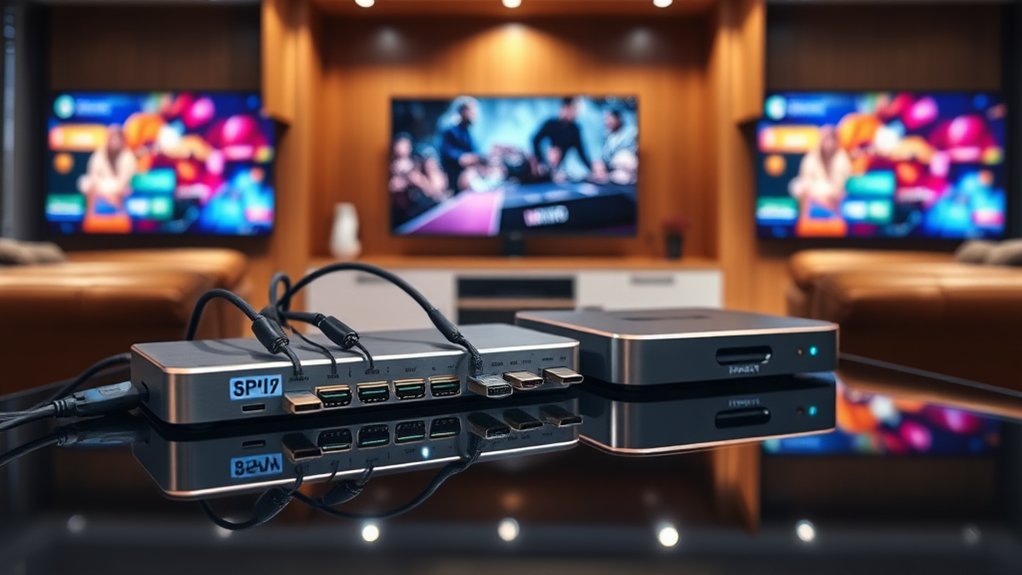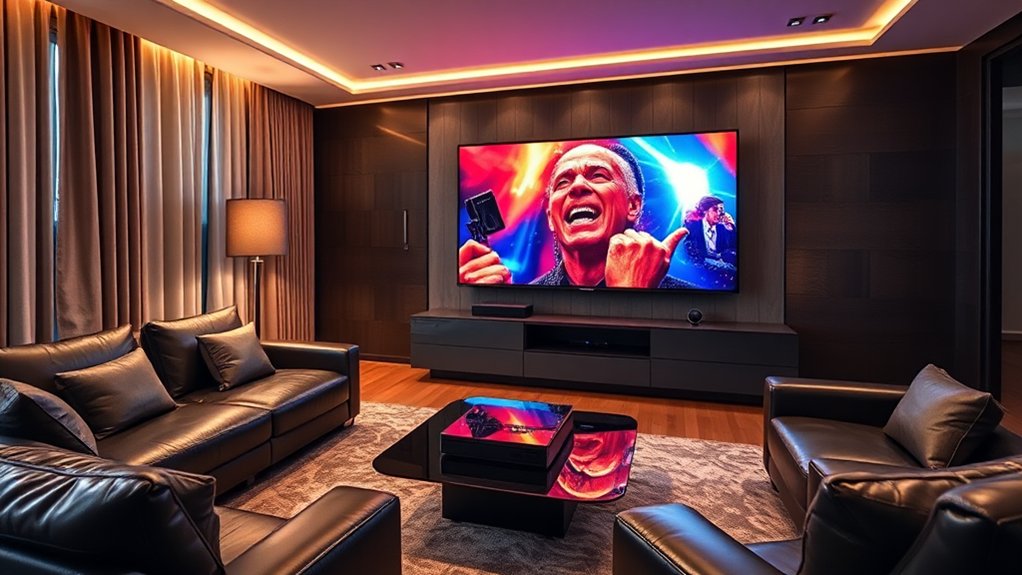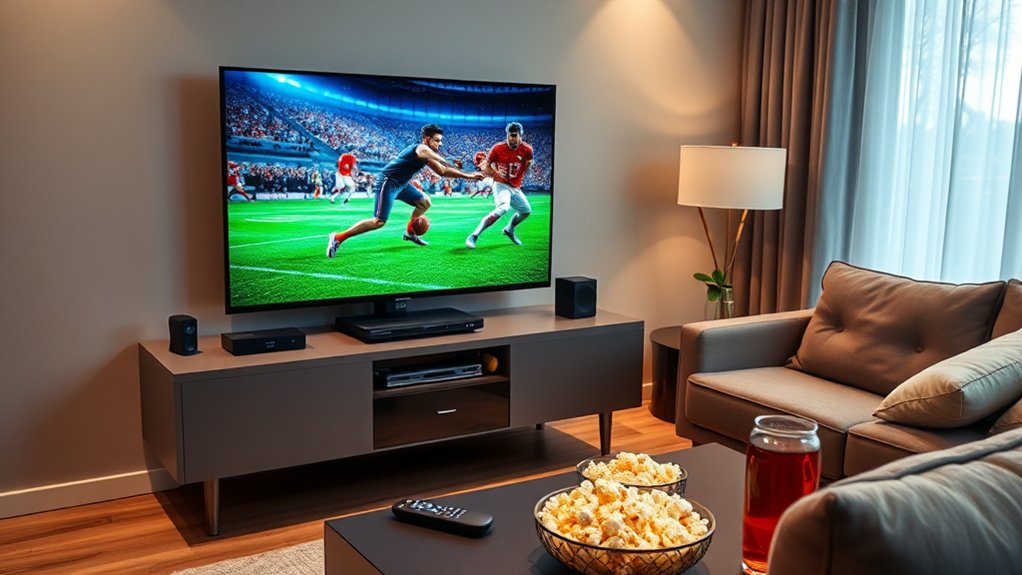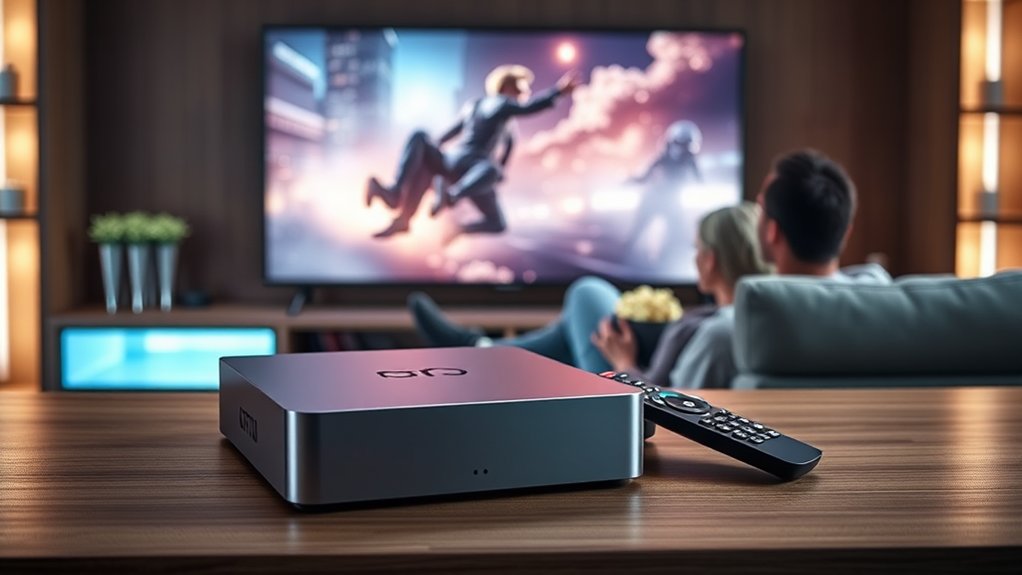To connect your streaming boxes to multiple HDMI outputs, consider using an HDMI splitter. This device copies the signal from one source to several displays, making it perfect for presentations or digital signage. First, verify your splitter supports 4K for the best picture quality, and check that it’s powered on. Once you’ve got everything set up, plug in your devices and confirm that connections are secure. Interested in more tips to improve your setup? Keep going!
Key Highlights
- Utilize an HDMI splitter to send a single streaming box signal to multiple displays simultaneously.
- Choose a splitter that supports at least 4K@60Hz for enhanced video quality.
- Confirm that all devices and cables are compatible with the necessary resolution and refresh rate.
- Ensure the splitter is powered externally for stable performance during use.
- Power off all devices before connecting to avoid electrical issues and ensure secure connections.
Understanding HDMI Splitters and Switchers
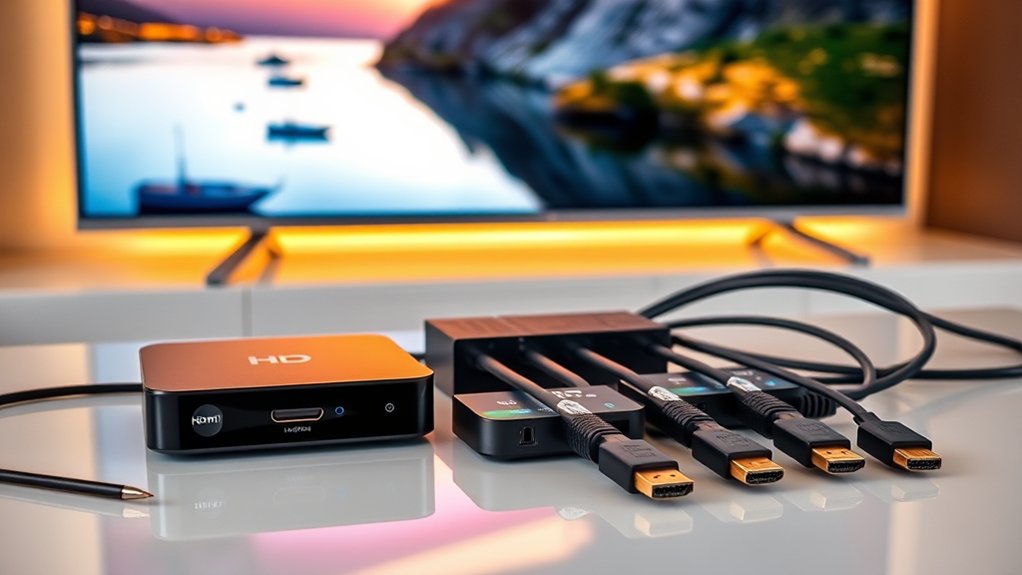
When you’re setting up your entertainment system, understanding the differences between HDMI splitters and switchers can make a world of difference.
HDMI splitters take a single source signal — like your streaming box — and send that identical feed to multiple displays. Think of it as copying a movie onto several DVDs; the same content plays on each screen. This functionality is useful for mirroring presentations across multiple screens or for digital signage. Moreover, many options such as the AV Access HDMI Splitters can support resolutions up to 4K@60Hz for optimal viewing quality.
HDMI splitters replicate a single source signal, delivering the same content to multiple displays seamlessly.
Conversely, HDMI switchers let you connect multiple source devices, like gaming consoles and Blu-ray players, to one display, simplifying your setup and eliminating the need for constant cable swapping.
Now, in contrast to switchers, splitters are perfect for mirroring, while switchers allow you to select different sources without a hassle.
Got it? Just remember: splitters duplicate, whereas switchers choose.
Choosing the Right HDMI Device for Your Setup
Choosing the right HDMI device for your setup can sometimes feel like maneuvering through a maze, but don’t worry; there are several key factors to reflect upon that can simplify the process.
Start by ensuring your device supports the highest resolution you need—think 4K at 60Hz. It’s likewise wise to contemplate how many outputs you need; common splitters offer 2 to 4, and switching devices might be better for multiple inputs. Additionally, consider choosing devices that support 4K resolution to ensure optimal picture quality for your streaming needs. Remember that an HDMI splitter can share one source across multiple screens, making it a great option if you want to view the same content on different displays at once. Furthermore, look for devices that feature HDMI ARC compatibility for enhanced audio return capabilities.
Power matters too—choose devices with external sources for stable performance.
Finally, compatibility with your streaming box and displays should be a priority; after all, you wouldn’t want to invest in a high-tech device that just sits there, silent as a rock!
Pre-Connection Checklist for Streaming Boxes
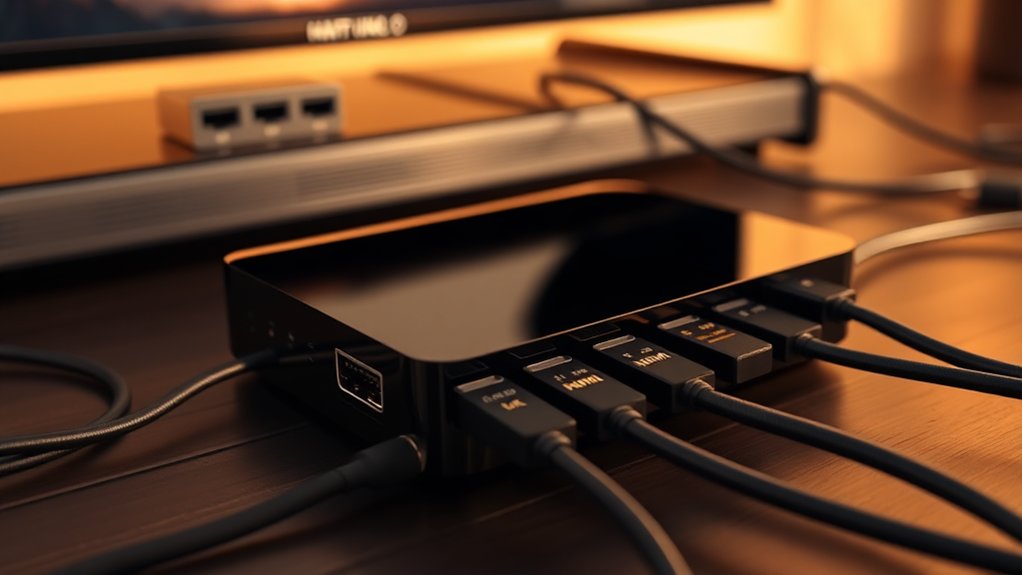
Before you plunge into connecting your streaming boxes, it’s vital to run through a pre-connection checklist that guarantees everything goes smoothly—after all, nobody enjoys the frustration of a tangled mess of cables and blinking error messages!
Start by cataloging all your streaming boxes and devices. Check that your HDMI cables are appropriately sized and compatible with each device. If you’re dealing with multiple outputs, you might need HDMI switchers or splitters, so make certain they’re powered and ready. Remember that an HDMI switcher serves as a solution for TVs that have few HDMI inputs but host multiple gadgets.
Then, inspect the HDMI ports on your displays to confirm they support the necessary resolutions and refresh rates. Finally, don’t forget to power everything off before you connect! It’s like keeping your ducks in a row, right?
Step-by-Step Guide to Connecting Devices
Connecting your streaming boxes to HDMI outputs can be a straightforward process if you follow a structured approach.
First, identify all your streaming boxes and the available HDMI ports on your displays—make a mental map, if you will. Gather your HDMI cables, ensuring they’re the right length for your setup.
If you find yourself short on inputs, an HDMI switch or splitter is your next best friend. Power down everything before connecting to avoid any electrical mishaps.
Once connected, be certain each cable is firmly seated; loose connections can turn your movie night into a mystery.
Finally, power up the devices, and enjoy the show—unless you’re still stuck wondering why the remote’s not working!
Verifying Signal Quality and Functionality
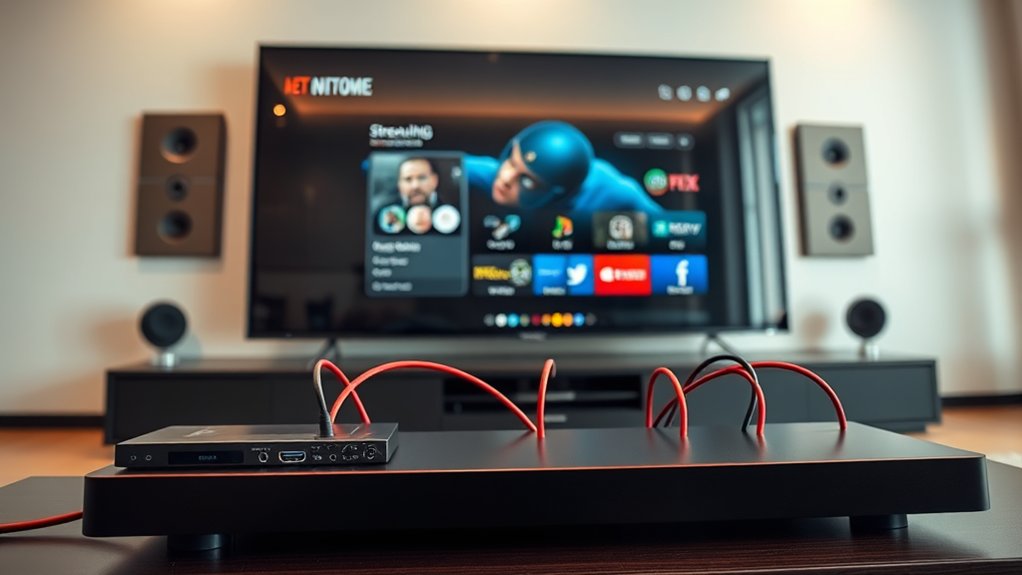
In relation to enjoying content from your streaming boxes, verifying the signal quality and functionality is essential to avoiding those bothersome moments of frustration during your viewing experience.
You’ll want to check for intra-pair skew, ensuring timing differences don’t exceed 15% of the bit time—think of it as keeping a good rhythm. Next, low-level output voltage testing is vital; ensuring your TMDS lines sit between 2.7 to 2.9 V keeps your HDMI signal stable.
For video, eye-diagram analysis visually assesses signal quality, whereas continuity testing helps catch sneaky shorts or resistance issues that could lead to signal degradation.
Troubleshooting Common HDMI Issues
When you’re cozied up for a binge session only to be greeted by a frustrating black screen or flickering image, you might feel like pulling your hair out.
But don’t worry—troubleshooting HDMI issues can often be simpler than it seems.
Start by checking your HDMI cable for bent pins or visible damage; a cable’s integrity is essential. Ensure it’s snugly connected to both your source and display, or try different ports to see if one’s defective.
If you encounter handshake issues (trust me, they’re common), try restarting your devices to reset connections.
Finally, adjust resolution settings to something standard like 1080p 30Hz.
With a bit of patience, you’ll have those streaming services flickering back to life in no time!
Tips for Maintaining HDMI Signal Integrity
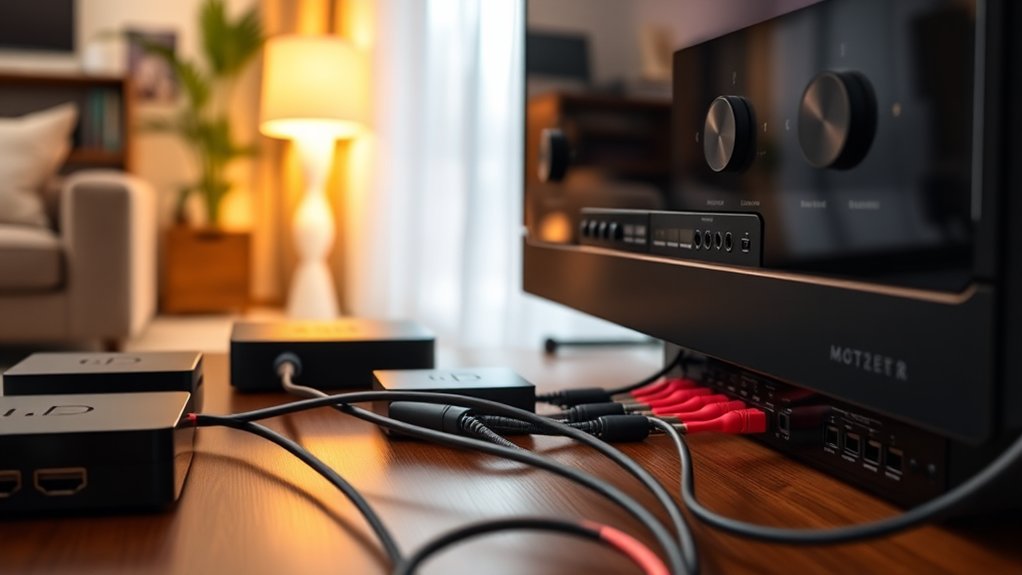
To keep your HDMI setup running smoothly, it’s essential to maintain the integrity of your signal, especially in an era where high-definition content reigns supreme.
Start with high-quality HDMI cables; they’ve thick conductors and multi-layer shielding designed to resist electromagnetic interference. Opt for cables that are certified for the latest HDMI standards, and don’t skimp on gold-plated connectors—they reduce corrosion over time.
If you’re dealing with long cable runs, consider using HDMI boosters or active cables to amplify signals as they travel.
Plus, managing your cables is important—avoid tight bundles that can cause crosstalk.
Finally, don’t ignore wear and tear; regularly inspect cables and replace any that look damaged or worn out. After all, you wouldn’t drive a car with bald tires, right?
Frequently Asked Questions
Can I Use an HDMI Switcher and Splitter Together?
Yes, you can use an HDMI switcher and splitter together. This setup allows you to select a source device with the switch, then duplicate that signal to multiple displays using the splitter effectively.
What’S the Maximum Distance for HDMI Signal Without Degradation?
The maximum HDMI cable length is typically 3 meters for 4K signals. Though some high-speed cables can reach 15 meters under ideal conditions, distance beyond that risks significant signal degradation, affecting quality and reliability.
Do All HDMI Cables Support 4K Resolution?
Not all HDMI cables support 4K resolution. Verify your cable specifies 4K Ultra HD support, ideally with HDMI 2.0 or 2.1 certification, to guarantee the best picture and audio quality for your devices.
Are There HDMI Devices With Wireless Switching Capabilities?
Yes, there are HDMI devices with wireless switching capabilities. These devices allow you to effortlessly switch between different sources without the hassle of cables, enhancing your viewing experience across multiple displays in your entertainment setup.
Can I Connect Devices With Different HDMI Versions Together?
Yes, you can connect devices with different HDMI versions together. Just keep in mind that the performance will default to the capabilities of the lowest version in the connection, so advanced features might not work properly.

